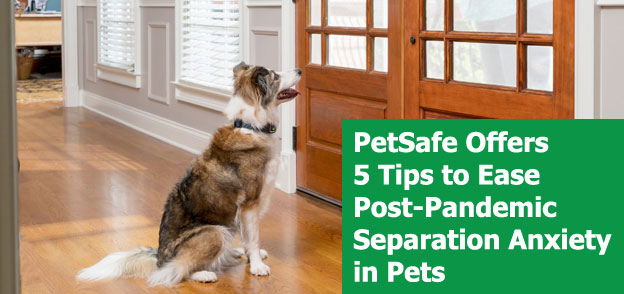After more than a year of quality time with their pets at home, dog and cat parents are planning a return to the office, making travel plans, or simply leaving for social outings as the pandemic slows. With these new routines and a return to life post-pandemic, pets are at the risk of suffering from separation anxiety.PetSafe® brand partnered with dog training expert, Tom Shelby, to help identify signs of anxiety in pets and how best to manage the separation.
“I’ve seen many cases of separation anxiety over the years, but I became much more concerned in the pandemic,” says Tom Shelby, pet behaviorist and author of Dog Training Diaries. “Many people adopted dogs, which is a wonderful thing, but these new pets have hardly been left alone.”
Shelby adds, “I tell my clients that even if they’ve had a dog for a while, after being home with them for so long during lockdown, their dog can potentially still develop separation anxiety when they transition back to work and the like.”
Symptoms of separation anxiety in dogs and cats can range from destructive chewing and scratching on furniture, destroying items in the home, urinating or defecating indoors, and excessive barking or meowing. When the time comes to return to work or other activities outside the home, PetSafe® and Tom Shelby recommend the following five tips to help your pet avoid developing separation anxiety.
- De-emotionalize leaving and coming back home.
When you are leaving the house or coming home, it is important to stay composed. If you appear sorry to go or overly excited to return, that may emphasize the separation. Greet your pet calmly and without emotion each time.
- Make your departure happy by leaving treats or treat-holding bones.
When you’re leaving, give your pet a special treat or toy to take their mind off your departure like the Busy Buddy® Bristle Bone® or the Busy Buddy® Jack. Long-lasting play can help ease your dog’s anxiety, and if you remove the treat toys when you return from work, your pet will associate this fun activity with you not being home.
- Engage in exercise and play sessions.
Stay active with your pet. Before leaving, take your dog for a long walk in a PetSafe® no-pull solution like the Easy Walk® Harness. Shelby adds, “There is an expression that says, ‘a tired dog is a well-behaved dog’ and it’s important to give your dog a good walk or play session when you can.”
- Give your pet a mentally stimulating toy while you are away.
Challenge your pet with a mentally stimulating toy like the Kibble Chase™ Roaming Treat Dropper or the Ricochet Electronic Dog Toy while you are away. The Kibble Chase™ moves in an unpredictable rolling action while randomly dropping treats to entice your dog, and the moving squeak of the Ricochet provides a fun puzzle, as the sound is never where he expects it. Interactive toys will keep your dog’s interest until you return home.
- Practice leaving your pet at home.
In the days and weeks leading up to your return to the office or travel, practice leaving your pet at home – if only for half an hour. Shelby emphasizes, “There is no domestic animal that denotes the body language of a human better than a dog. When you’re getting ready and start to put on clothing and shoes to show that you are leaving soon, you may see your pet start to get a bit anxious. It is important that they get accustomed to being home alone.”
Pet parents that are concerned about their dog or cat’s anxiety are encouraged to seek professional advice from their veterinarian. Additional resources for dealing with separation anxiety in pets can be found at petsafe.com or in Tom Shelby’s book, Dog Training Diaries.

